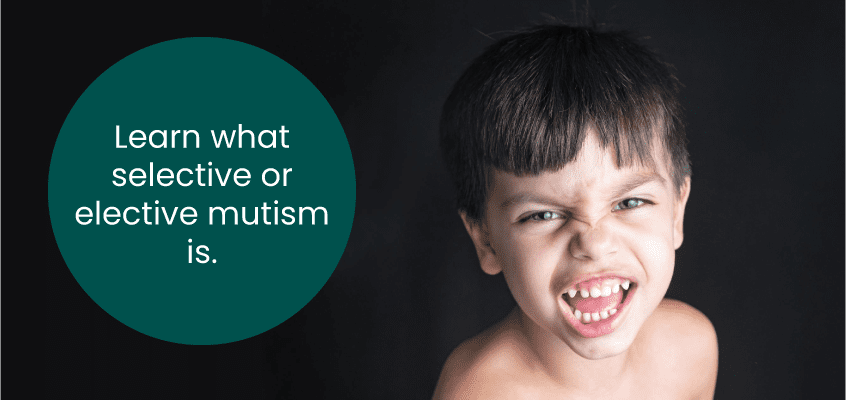Have you ever encountered a youngster who felt more at ease conversing with people they knew than they did with strangers? It would be a case of selective mutism,[1] and elective mutism affects a child’s ability to speak in various social settings such as school or social gatherings.
A childhood anxiety disorder may cause selective mutism. If untreated, it has several consequences, like social anxiety and lack of self-esteem. The condition can persist and continue through adulthood.
What is selective mutism?
Selective mutism (elective mutism) is an anxiety disorder in children that requires professional help. Children with selective mutism often cannot speak because of anxiety. A child with selective mutism cannot express themself in certain social situations or with certain people but is otherwise talkative.
Selective mutism (elective mutism) is a trigger response to anxiety. It is natural for a child to feel anxious in social settings or the company of strangers. But selective mutism lasts longer, affecting the child’s learning and overall development.
Selective mutism also affects a child’s ability to start non-verbal communication. A child suffering from this condition cannot express themselves in unfamiliar settings despite a desire to speak whenever there is a sense of expectation.
Selective mutism presents in different ways; some children may remain aloof, while others may try muttering or whispering when asked a question.
Symptoms of selective mutism (elective mutism)
Children with selective mutism[2]may exhibit various behavioural and physical characteristics. One should note that these children behave ordinarily in familiar surroundings, like at home. There is a significant change in their behaviour when they are out of their comfort zone, and they may not even speak with their parents in unfamiliar social settings. The following are a range of symptoms exhibited by children with selective mutism.
Behavioural symptoms
-
Trouble responding to parents in unfamiliar settings
-
Difficulty concentrating or thinking clearly
-
Inability to make new friends or play with kids not familiar to them
-
Fear of attention during social events
-
Avoiding participation in sports or stage events in school
-
Tendency to look away or look at parents while someone is speaking or looking at them
-
Whispering or using few words when responding to others
Physical symptoms
-
Restlessness
-
Frigidity
-
Appears tense
-
Blushing
-
Trembling
-
Dry mouth
Visit unitedwecare.com today if you notice any of these symptoms in your child.
Causes of selective mutism (elective mutism)
Several causes of selective mutism (elective mutism) in children, including genetic factors. The child has difficulty adjusting to unfamiliar people because of fear and anxiety of public embarrassment. Let’s look at some of the probable causes of selective mutism.
- Sensory processing disorders: A child with selective mutism may exhibit high sensitivity to smells, tastes, lights, and sounds. They may experience trouble processing sensory information and shut themselves down to deal with the situation.
-
Language, hearing, or speech conditions: Disorders of speech, hearing, or language may cause a child to become inflexible as they experience stress during verbal communication.
-
Family background: Raising children in a multilingual or bilingual environment may cause selective mutism. Children who migrate to foreign countries will likely suffer from selective mutism because of language issues.
Selective mutism (elective mutism) is an anxiety-related disorder. Like most mental health conditions, there is no single cause for this condition. The ongoing research hints at the involvement of genetic factors in causing elective mutism.
Diagnosis and treatment of selective mutism (elective mutism)
A mental health professional or behavioural expert will assess the child’s behaviour and communication in diverse settings. They will also check the speech, hearing, and language abilities that may cause selective mutism[3]. The following observations may help a mental health professional arrive at the diagnosis of selective mutism among children:
- The child cannot speak in specific surroundings and situations, like a school environment or a social gathering.
-
A significant difference exists between the child’s behaviours within and outside the comfort zone.
-
The child cannot speak in an unfamiliar environment, interfering with their performance.
-
The child cannot talk or interact in particular surroundings or with certain people. The problem has persisted for over a month.
-
There is similar feedback from parents and teachers.
Early diagnosis of selective mutism (elective mutism) is helpful, as the condition is most receptive to treatment in the early stage. Treatment for selective mutism involves eliminating the stress of speaking by using relaxing techniques in school or a social environment. Gradual exposure therapy, such as a step-ladder approach, is crucial to achieving slow and steady progress from non-verbal to verbal communication for the child.
Conclusion
Selective mutism (elective mutism) is a severe anxiety disorder at a young age. It is a rare condition affecting less than 1% of U.S. children with elective mutism who cannot speak in public places or classes.
Parents often neglect their child’s inability to speak in unfamiliar settings as a normal response and assure themselves that the child will grow out of it. They may also misinterpret the behaviour as a sign of shyness or defiance. It may lead to failure to seek treatment, impairing the child’s development.
Failure to treat it can cause social isolation. The condition can continue influencing the child’s behaviour and progress throughout childhood. It can also persist during the teenage years if there is no appropriate treatment in the early stage. An early diagnosis and treatment by a mental health professional are crucial for a positive outcome.
Visit unitedwecare.com to seek professional help for your child today.











